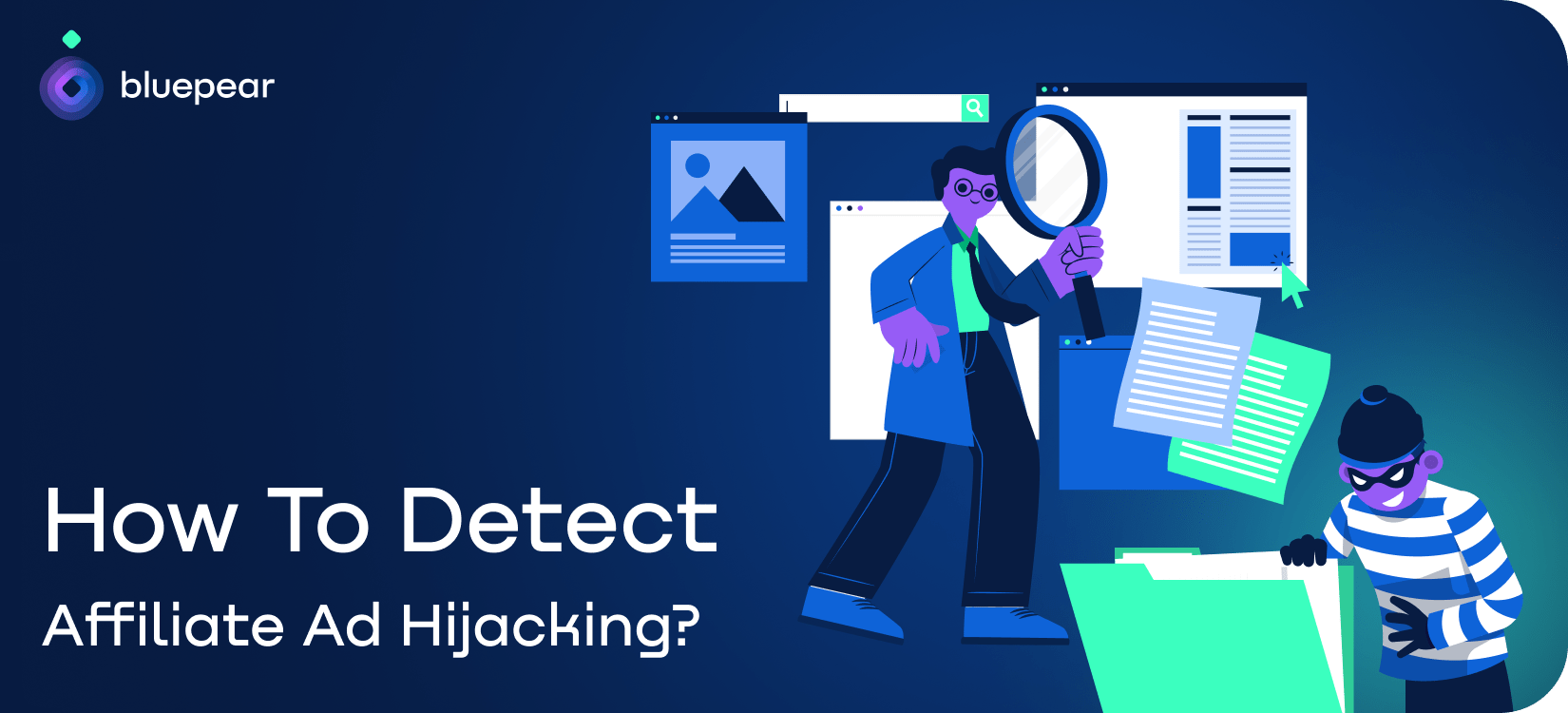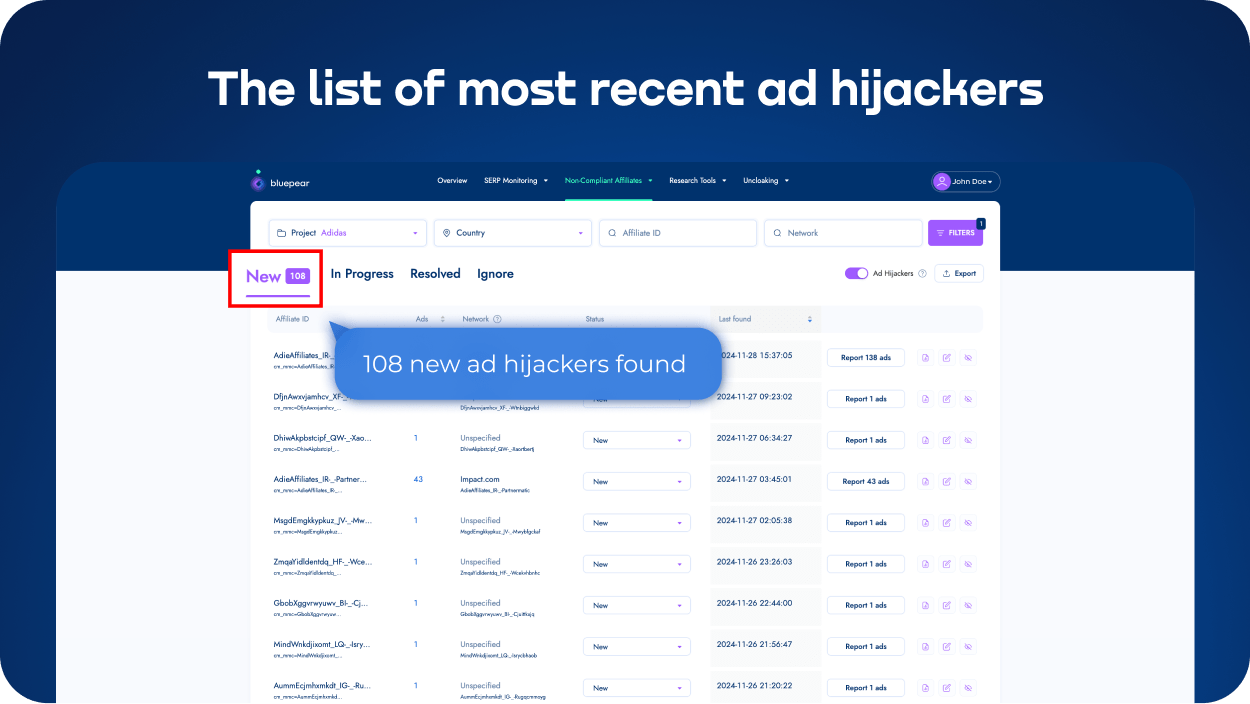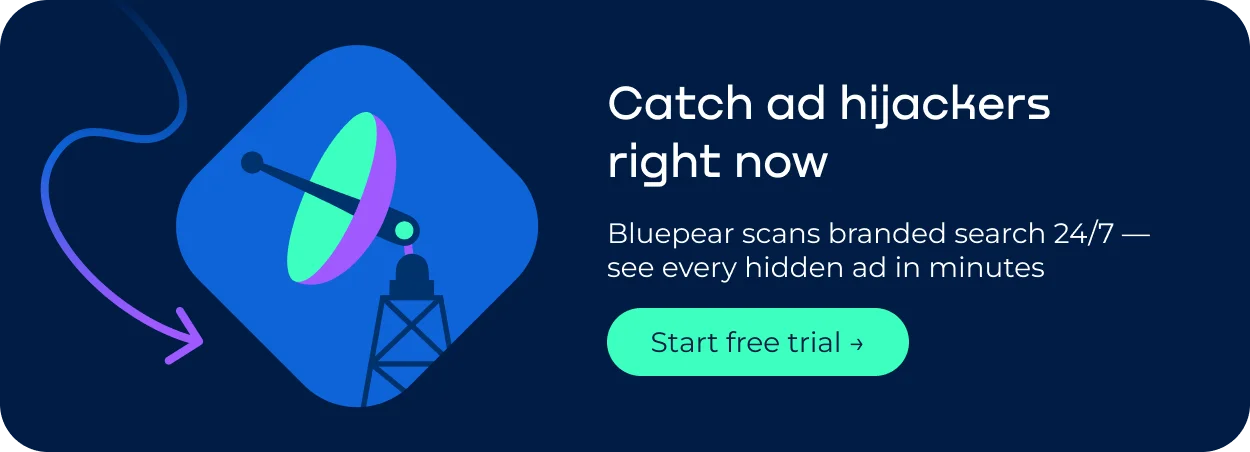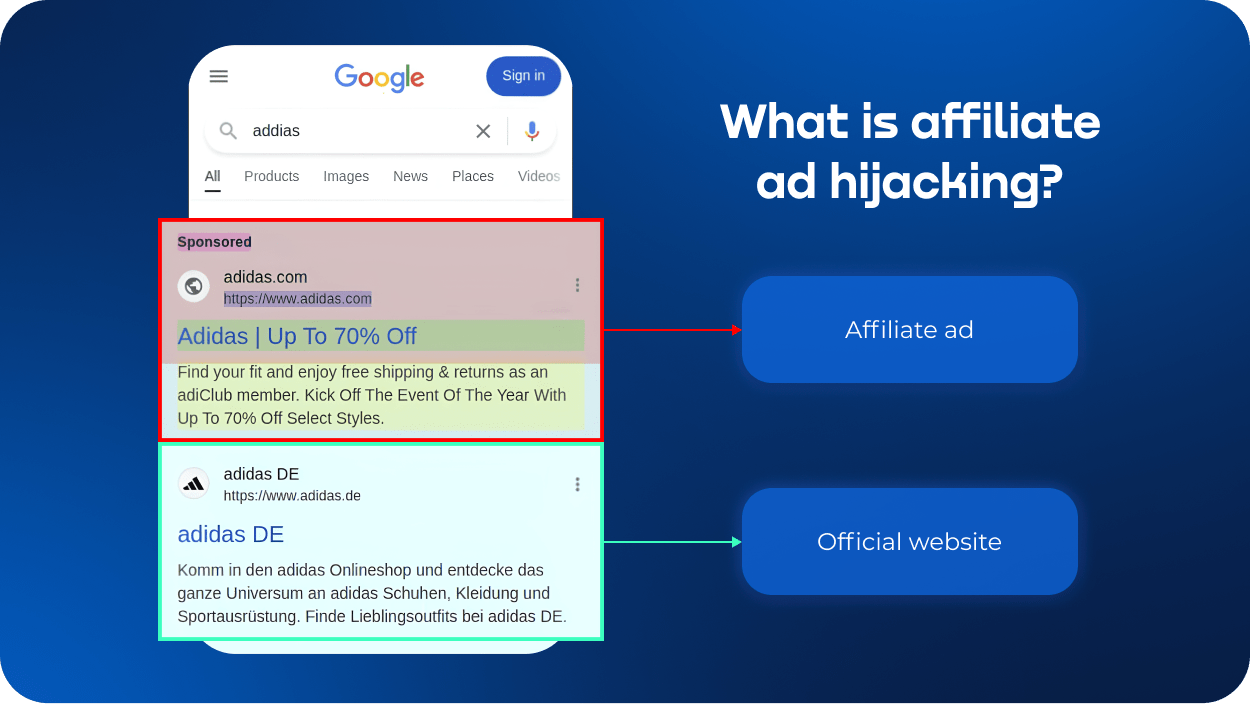
Contents
Digital ad budgets are getting bigger and so is the level of online ad fraud. Ad hijacking is one of the most common threats in 2025. This’s when affiliates pretend to be a brand and redirect traffic that was meant for that brand. To do that, a hijacker makes an ad that looks almost exactly like a brand's official campaign. They do this by copying headlines, ad text or display URLs and then sending clicks to hidden affiliate links.
In 2025, according to Neil Patel, 75% of affiliate ad hijacking cases are due to the actions of affiliates who use loopholes in tracking and securing to earn commissions they don't deserve.
The effects on brands are serious: wasted money, inaccurate analytics and damage to their reputation. For instance, brands might have to pay commissions on clicks that would have happened naturally or CPC might go up because hijackers are competing for branded keywords.
In this article, we'll talk about the different kinds of ad hijacking, the risks involved, the example of Adidas and how automated ad fraud solutions like Bluepear can help stop these schemes.
What Is Ad Hijacking?
When a third-party affiliate runs ads that look almost exactly like a brand's official ads, that's called ad hijacking. These ads look real to users because they copy headlines, pictures and even display URLs. But behind the scenes, the hijacker's tracking links send clicks to them, which lets them claim commissions or change traffic without really helping the brand.
Affiliate link cloaking is a common trick that hides where the traffic really goes. Because of this, the brand or ad platform often can't tell right away that the visit was redirected by a hijacker. Users may get to the right website but the affiliate gets credit for clicks or conversions that should not have been theirs.
Sometimes, redirects go through more than one page before they get to the final site. This makes it even harder to find the route and spot fraud. Because of these hidden paths, brands may remain unaware of the problem until they notice unexpected drops in performance or inflated affiliate payouts.
Affiliate ad hijacking quietly drains revenue, skews marketing data, and introduces risks the brand might not anticipate.

Types of Ad Hijacking Hijack advertising shows up in multiple ways and each method can hit a brand differently. By looking at these tactics closely, you can see where traffic might be diverted or analytics skewed.
-
Malicious Scripts Some affiliates sneak scripts into ads on well-known networks. When users click, these scripts can redirect them to other sites, slow page loading or collect data. This harms your brand by driving away visitors and reducing trust in your site.
-
Hidden Clicks and Redirected Ad Blocks Some ads look normal but when users click, they get sent through a few extra pages before reaching your site. Those extra steps boost the hijacker’s commission and scramble your campaign numbers.
-
Brand Bidding Some affiliates create sites that look like yours or use your brand name in search keywords. Their ads can appear above your official campaigns. This pulls clicks away and can raise your cost per click. It’s risky because it competes directly with your ads and drives up spending.
-
Affiliate Hijacking Partners copy your ads - the headlines, descriptions, even the visuals - and add their own affiliate links. People still reach your site but the hijacker pockets a commission. Your reports get messy: affiliate numbers look higher than they really are, and direct or organic traffic seems smaller.
You need to notice these affiliate ad hijacking moves early. Otherwise, without an ad hijacking solution your budget takes a hit and your numbers get confusing.
| Type | Impact | How it works | Risk |
|---|---|---|---|
| Malicious Script Insertion | Financial loss, device exposure | Scripts injected via ad networks | Compromised content, misdirected traffic |
| Hidden Clicks/Ad Injection | Distorted analytics, wasted budget | Extra ad blocks or redirects | Misattributed conversions, confusion |
| Brand Bidding | Higher CPC, lost traffic | Bids on brand keywords or domain clones | Reduced ad efficiency, user trust issues |
| Affiliate Ad Hijacking | Inflated payouts, misleading metrics | Copies ad copy or creative to earn commissions | Loss of organic credit, false performance data |
Why Ad Hijacking Matters in 2025
Paid search is booming, yet digital affiliate ad hijacking is catching up. Spider AF estimates that losses will hit $41.4 billion in 2025, a jump of almost 10% over last year.
-
• Financial losses. Scammers are able to redirect traffic that should have come to you to their own pages. As a result, you end up paying for clicks that don't generate real sales, wasting your budget.
-
• Increased cost per click (CPC). If scammers bid on your branded keywords, the cost per click increases. You start spending more money on the same ad positions, especially in competitive niches.
-
• Distorted analytics. Hidden redirects and click fraud make your analytics unreliable. You might think an affiliate is performing well but in reality the traffic and sales aren’t coming from them. It’s easy to lose track of which channel is really sending customers without a proper ad fraud solution.
-
• Reputational risks. If users are exposed to fraudulent ads through your brand, they may blame you. It chips away at trust and makes visitors think twice about coming back.
If you relax your attention, part of the budget will go into someone else's pocket and statistics will become fiction. Only ad hijacking solutions that search for and cut such attacks in real time are saved.

The Challenge of Manual Detection
Some brands still rely on a quick Google of their own name to spot shady ads. It feels like an easy check, but it rarely works. Fraudsters schedule their campaigns for odd hours, focus on certain regions and cloak their redirects, so you never see the real thing when you look. A quick check from your office computer may show everything as normal, even though users in other locations are seeing ad hijacking.
Some ad hijackers are even more clever when they use cloaking. If they see a search coming from a brand monitor or automated tool, they show a normal-looking page instead of the ad that was hijacked. This is where advanced affiliate decloaking methods become essential — uncovering hidden redirects and cloaked affiliate paths that manual tools can’t detect. You might not see the problem unless you look at it on different devices, in different places, and at different times thanks to good ad fraud solutions.
Brands need to constantly monitor affiliate ad hijacking in a way that mimics how real users would act in different situations. Before they mess up campaign data or drain budgets, hidden ads, masked redirects and affiliate cloaking can only be found then.
Case Study: Adidas - Over 100 Instances in 40 Days
Bluepear began keeping an eye on Adidas ads on a variety of search engines, countries and devices. In just 40 days the system found more than 100 cases of ad hijacking. Some affiliates copied the headlines and images from Adidas's ads. In a lot of cases, these ad hijackings showed up above the official ones, which made people click on them instead and raised the cost of advertising.
The team also found 245 different ad variations. Some changed a single word, others adjusted the phrasing or layout. All were designed to hide and look legitimate to users.
The Bluepear dashboard shows violations clearly. You can see screenshots of search results, landing pages and the responsible affiliate IDs. Filters allow checking by location, device or time of day. This makes it easy to understand how traffic was redirected and which ad versions were involved.
When we started monitoring Adidas, we quickly uncovered hundreds of hidden ad hijackings in just over a month. Many of these would have slipped past manual checks. Bluepear as an ad fraud solution lets the team spot each issue in real time and take action right away, keeping campaigns on track and budgets safe.

Preventing and Detecting Ad Hijacking
The brand should use a multi-level ad hijacking solution that includes technical protection, partner control and automated monitoring to lower the chances of ad hijacking.
Protect websites and accounts
With complex passwords, enable two-factor authentication and update your software regularly. These measures prevent unauthorized access and reduce the likelihood that fraudsters will gain control over advertising accounts or website resources.
Picking trustworthy networks and partners
Only work with advertising networks and affiliates that you can trust. Checking a partner's reputation and making the terms of cooperation clear can help lower the chances that they will use hidden methods or click fraud to steal commissions.
Keeping an eye on ad campaigns
Look for strange things in CPC, conversions and traffic sources on a regular basis. Use UTM tags to keep track of and analyze where users come from and how they interact with ads. Indicators that jump or change suddenly could mean that something is going on behind the scenes.
Setting up terms and conditions for partners
Clearly formulate a ban on brand bidding, affiliate decloaking and direct redirects to your pages. These rules make fraudulent actions a violation of the contract and simplify the taking of measures in case of violations.
Using automated tools
In 2025, manual checks are no longer effective: hundreds of locations, keywords, and devices cannot be monitored manually. Ad fraud solutions like Bluepear help you find hidden ads, fix redirects, and find affiliates who break the rules quickly. They also integrate with modern affiliate fraud detection frameworks, giving you real-time visibility across all affiliate channels and protecting revenue from fraudulent commissions. Automation helps you get correct information, cut down on mistakes, and respond right away.
Putting these steps together makes a strong shield against ad hijacking, cuts down on financial losses, protects the brand's reputation and makes it easier to manage advertising campaigns.
Why Bluepear Beats Manual Tools
Bluepear completely fixes the problem of ad hijacking by offering many levels of protection and control.
Constant monitoring
The service works 24/7, checking advertising campaigns from different IP addresses and devices in different countries. This means that even if affiliates run hidden ads at night or in a remote geo-zone, the platform will detect a violation.
Advanced De‑cloaking & Anti‑Hijacking
Bluepear recognizes hidden partner IDs and unobvious redirects that usually go unnoticed during manual checks. This way, hidden attempts to steal commission or traffic are quickly identified.
Extended Scanning
The platform views not only standard advertisements, but also coupons, storefronts and bridge pages, where posters often hide. This allows you to detect even intricate schemes that are inaccessible to conventional tools.
Own dashboards and violation management
All identified cases are displayed in the interface with the statuses New, In Progress and Resolved. Sending notifications of violations is possible directly from the system, which saves time and simplifies paid search monitoring.
Easy launch and setup
Registration and launch of the project takes only a few minutes. The first results can be seen in an hour, and the setting of keywords, geo, and frequency of checks remains flexible.
Convenient payment
Starts at $169, a trial period is available and the card is managed via Stripe.
Unlike most traditional anti-click fraud services, which are limited to IP blocking, Bluepear works with brand bidding and affiliate fraud - this’s a much broader reach and real protection of the advertising budget.
This ad fraud solution has positive user reviews: on G2, its rating is 4.6 out of 5, which confirms the effectiveness and convenience of working with the tool.
Conclusion
Ad hijacking costs brands money and trust. Manual checks miss too much. That’s why the most reliable way to protect traffic and advertising budget in 2025 is a multi-level approach combining security, monitoring, partner rules and automation.
With Bluepear you can immediately see where traffic interception attempts are hiding and regain control of your advertising campaigns. Try the platform today - registration will take only a few minutes, and the first results will appear in an hour.
FAQ
What is ad hijacking?
Ad hijacking happens when someone copies your ads such as headlines, text, even URLs and sneaks their own affiliate links in. The user may still reach your site, but the hijacker pockets a commission they didn’t earn.
Why should I worry about ad hijacking in 2025?
It’s not just about losing a little money. Hijackers drive up your CPC, skew your analytics and can hurt your brand’s reputation. Essentially, they’re stealing traffic and commissions that should go straight to you.
How do hijackers hide what they’re doing?
They get creative. Some use hidden redirects or affiliate link cloakers. Others only show ads at night or in certain regions. That’s why just checking your own ads manually often won’t catch them.
Can I detect ad hijacking by myself?
No. Typing your brand name into a search engine won’t reliably reveal these tricks. To catch them, you need automated monitoring that scans multiple locations, devices, and times.
How does Bluepear make this easier?
Bluepear tracks hidden redirects, finds cloaked affiliate IDs, takes screenshots and provides clear dashboards. You can see who’s violating rules and take action quickly, protecting your traffic and campaigns.

